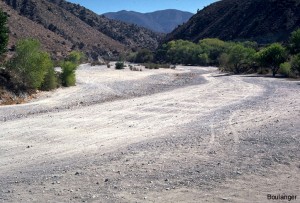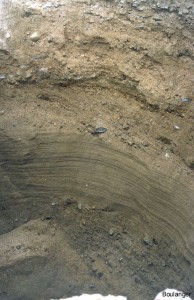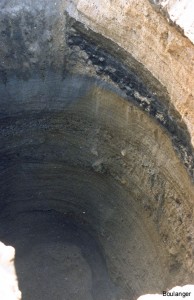Upstream of Littlerock Dam, California
These photos are from test pit explorations in the alluvial deposits upstream of Littlerock Dam, California. The test pits allow us to see the subsurface stratigraphy in more detail than is possible with conventional borings. Imagine trying to infer the stratigraphy using SPT samples taken every 1.5-m in boreholes spaced 15-30 m apart. This simple exercise is a valuable learning opportunity and worth repeating every time you come a across a cut-exposure of soil or rock. This is because Geotechnical engineers must understand the limitations of most site characterization methods for capturing certain subsurface details, and understand how the resulting uncertainties affect different design procedures.

This is a view of the valley floor upstream of Littlerock dam. The ground surface is comprised of sand and gravelly sand. A series of test pits were excavated in this area to determine the quantity and quality of aggregate materials that might be used in a roller compacted concrete modification of the existing dam.

Test pits were excavated by backhoe. This can be a very economical way of rapidly performing shallow explorations in undeveloped areas.

This test pit showed a sequence of gravelly sand, sand, and more gravelly sand. The gravel contents are relatively low in this test pit.

This test pit is perhaps 50-100 m away from the test pit shown above, and it encountered predominantly sandy gravels. There is substantially more gravel at this location, and there are occasional boulder- and cobble-sized particles.

This test pit is located between the above two test pits and towards the side of the valley. An organic soil layer (black) was encountered along with the sand and gravely sand layers. Common borehole sampling techniques with samples obtained at 1.5-m spacings or more could easily have missed this highly compressible layer. Organics are detrimental to roller compacted concrete applications, and thus identifying these layers was important to the project.
